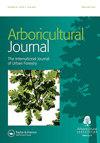The extent of stunting in trees growing within car parks compared with those situated in peripheral landscaped areas in the UK
Q3 Agricultural and Biological Sciences
引用次数: 1
Abstract
ABSTRACT Tree planting in towns and cities offers a range of important social, economic and environmental benefits; however, the harsh growing conditions of urban sites can substantially limit these benefits. This study investigated the effect of a car park environment upon the growth and development of trees planted within 13 sites in the UK. The size and condition of trees planted 11 to 27 years ago in restricted soil volumes surrounded by car park surfaces (n = 160) were compared to trees of the same age and species situated within the landscaped peripheries (n = 33) of 13 sites. Crown density was assessed at three sites planted with Acer platanoides L. as an additional measure of tree health. Analysis of stem diameter identified that trees in the landscaped areas exhibited 64.2% greater girth when compared to those planted in pits and 49.9% greater girth compared to those planted in strips within car park areas (excluding sites containing Platanus x acerifolia (Aiton) Willd., which coped well within car parks). Trees in peripheral landscaping areas were on average 20% taller in height and tree condition was significantly associated with estimated soil volumes. Sampled crown density also identified that the Norway maples within three car parks had around 30% sparser crowns than trees of the same species planted in adjacent landscaping areas. This study concludes that species and substrate conditions are crucial factors influencing the growth of most tree species in a car park setting. The stunted trees arising from inadequate car park design in the last three decades in the UK provide a sanguine lesson on how not to establish the urban forest of the future与英国周边景观区的树木相比,生长在停车场内的树木发育迟缓的程度
城镇植树具有一系列重要的社会、经济和环境效益;然而,城市场地恶劣的生长条件会大大限制这些好处。本研究调查了停车场环境对英国13个地点种植的树木生长和发育的影响。将11至27年前在停车场表面周围的有限土壤中种植的树木(n = 160)与位于13个地点景观周边的相同年龄和物种的树木(n = 33)进行了比较。在三个种植平台槭的样地评价树冠密度,作为树木健康状况的附加指标。茎径分析表明,园林绿化区树木的周长比坑地树种的周长长64.2%,比停车场(不包括野扁桃)带状树种的周长长49.9%。(它在停车场内运行得很好)。周边景观区的树木平均高20%,树木状况与估算土壤体积显著相关。树冠密度采样还表明,三个停车场内的挪威枫树的树冠比邻近景观区种植的同一树种的树冠少30%左右。本研究认为,在停车场环境下,树种和基质条件是影响大多数树种生长的关键因素。在过去的三十年里,英国由于停车场设计不当而导致的树木生长迟缓,给我们提供了一个乐观的教训,告诉我们如何不建立未来的城市森林
本文章由计算机程序翻译,如有差异,请以英文原文为准。
求助全文
约1分钟内获得全文
求助全文
来源期刊

Arboricultural Journal
Agricultural and Biological Sciences-Agronomy and Crop Science
CiteScore
2.40
自引率
0.00%
发文量
28
期刊介绍:
The Arboricultural Journal is published and issued free to members* of the Arboricultural Association. It contains valuable technical, research and scientific information about all aspects of arboriculture.
 求助内容:
求助内容: 应助结果提醒方式:
应助结果提醒方式:


